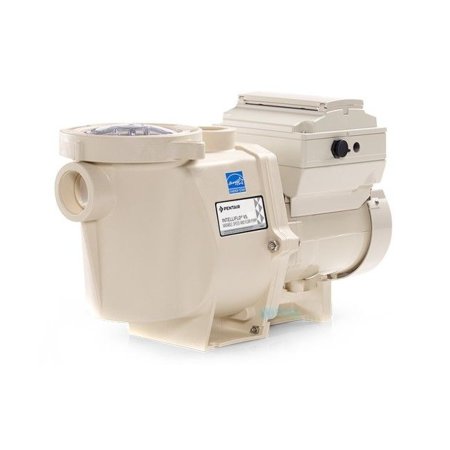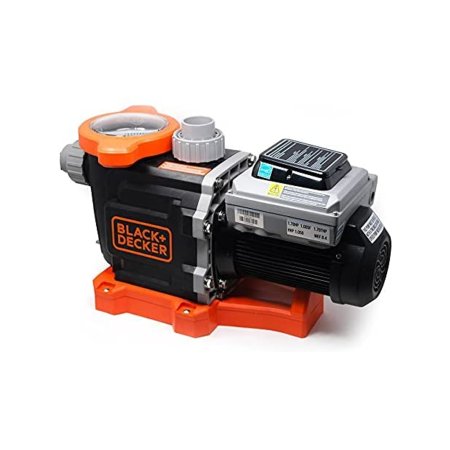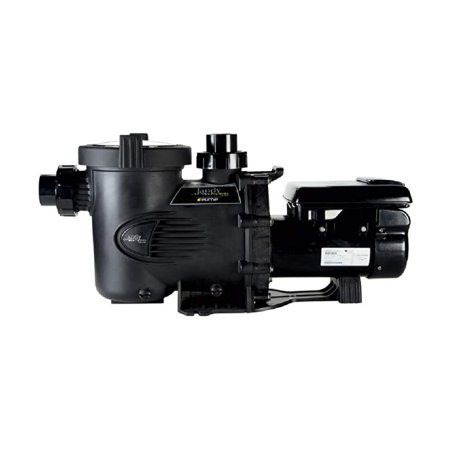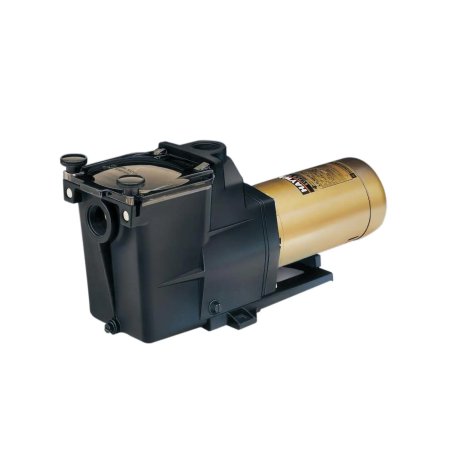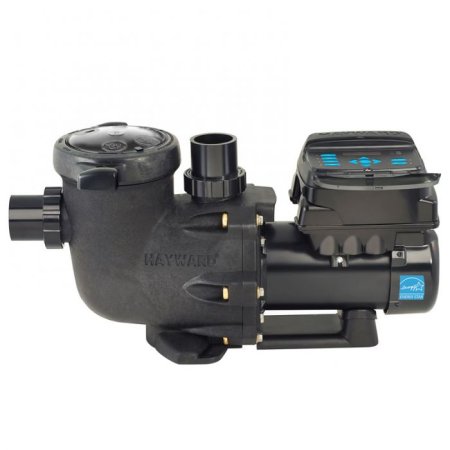We may earn revenue from the products available on this page and participate in affiliate programs.
Reading up on Domino’s shopping guides is like having your own personal product concierge. We do the tedious part—deep-dive research, hands-on testing, and tapping experts for advice—so all you have to do is hit “add to cart.” That’s why we call them Simply the Best.
Pool pumps—albeit not the prettiest to look at—are necessary for keeping your water flowing, filtering, and mixing in the necessary chemicals to keep the water crystal clear. A pump is typically hidden in a discrete area; Blythe Yost, cofounder of Tilly Design and a landscape architect, recommends using screening such as decorative fencing with horizontal pieces that have gaps for some air circulation.
“The first thing to know is there’s always a war between where the pool contractor wants to put the pool equipment that’s most efficient for his pool and where the homeowner wants it so it isn’t visible and you can’t hear it as much,” says Yost.
Selecting the proper pool pump is mostly dependent on the size of your pool, but there are other factors to consider like efficiency (those bills pile up fast!) and how much noise you’re willing to deal with. We tapped pool experts and builders to round up the best pool pumps to help you go with the flow.
Our Favorites
- Best overall: Pentair IntelliFlo Variable Speed High Performance Pool Pump
- Best value: Black + Decker Variable Speed Pool Pump
- Best variable speed: Jandy Pro Series JEP2.0HP ePump
- Best single speed: Hayward Super Pump Pool Pump
- Best energy efficient: Hayward TriStar VS Pump
Best Overall: Pentair IntelliFlo Variable Speed High Performance Pool Pump
Best Overall
Type: Variable speed | Filter compatibility: All | Speed: 15 to 134 GPM | Flow rate: 3 horsepower | Pool size: Medium to large
What we like:
- Energy efficient
- Quiet
- Rotating control pad
Worth noting:
- Expensive
Why we chose it: For the full monty, if you will, this filter promotes smooth and easy flow and allows you to adjust the speed based on your needs.
When choosing a pool pump, Caleb Brown, owner of Living Water Pool Service, almost always recommends using a variable-speed pump like this one, because you can control the water flow anytime, anywhere. They’re also much quieter compared to single-speed pumps.
The IntelliFlo, in particular, is ultra-quiet, running as low as 45 decibels all while having 3 horsepower (allowing it to hit eight programmable speed settings and run for 12 hours). The control panel is rotatable, making it easy to check and change its speed, and you can even connect it to an app to control all settings from your phone. Pool novices will also appreciate the built-in timer that changes the speed throughout the day for good filtration and maximum efficiency. “We have a long history with the IntelliFlo,” adds Brown, “and we know that longevity is there, quality is there, and its controls are undoubtedly user-friendly.”
Best Value: Black + Decker Variable Speed Pool Pump
Best Value
Type: Variable speed | Filter compatibility: All | Speed: 450 to 3,450 RPM | Flow rate: 1.5 horsepower | Pool size: Small to medium
What we like:
- Inexpensive for variable speed
- 5-year warranty
- Programmable
Worth noting:
- Not as fast as other variable models
Why we chose it: A slightly more affordable variable-speed option that still has four speed settings to choose from.
Powerful enough to pump water for spas and waterfalls (and of course pools), this no-fuss control system allows users to set programmable speeds at different times of day. For example, you can swap to a lower speed near the end of the day to save energy before turning off the pump. Not-so-handy folks will also appreciate that the included base can be adjusted to fit existing plumbing without having to re-plumb the fittings.
Best Variable Speed: Jandy Pro Series JEP2.0HP ePump
Best Variable Speed
Type: Variable speed | Filter compatibility: All | Speed: 600 to 3,450 RPM | Flow rate: 2.7 horsepower | Pool size: Medium to large
What we like:
- Safety Vacuum Release System
- Energy efficient
- 8 speed options
Worth noting:
- Expensive
Why we chose it: With energy efficiency and a Safety Vacuum Release System, you’ll have peace of mind.
Brown is also a fan of the Jandy ePump line and says the brand has implemented some modifications for efficiency at lower speeds, meaning the pumps are able to move the same amount of water at a lower speed, which saves on electricity. This one also has a Safety Vacuum Release System (SVRS) that can help aid in the prevention of full body entrapment hazards. Those who hate that humming noise that pumps frequently make will appreciate the brand’s Stealth Pump Technology, which allows for barely noticeable noise.
Best Single Speed: Hayward Super Pump Pool Pump
Best Single Speed
Type: Single speed | Filter compatibility: All | Speed: 6.5 amps | Flow rate: 1 horsepower | Pool size: Small to medium
What we like:
- Cheaper
- Not terribly noisy
- Good for large pools
Worth noting:
- Only 1 speed
Why we chose it: While simple, this single-speed pump doesn’t compromise at all on power.
While single-speed pumps tend to be a bit noisier than variable pumps, this one from Hayward only makes a little more than a hum and has the power to pump water to a large pool with its 1-horsepower motor. But if you want multiple speeds, there’s a dual-speed model option of this pump you can purchase. Plus with a design that enables air to flow through the motor, it runs at cooler temperatures, preventing overheating and extending the life of the pump. There’s also a strainer basket to collect a significant amount of debris for some pool-cleaning assistance.
Best Energy Efficient: Hayward TriStar VS Pump
Best Energy Efficient
Type: Variable | Filter compatibility: All | Speed: 600 to 3,450 RPM | Flow rate: 1.85 horsepower | Pool size: N/A
What we like:
- Energy Star certified
- Automatic speed change
- Extremely quiet
Worth noting:
- Expensive
Why we chose it: Designed for small to medium pools, this model can cut costs and use less energy in the process.
Named the 2022 Energy Star Partner of the Year, this variable-speed pump can achieve 90 percent energy cost savings compared to single-speed models. The 1.85-horsepower motor makes it powerful enough to pump small to medium pools without too much strain and is a great energy-efficient option. Because it has multiple speeds, you can use the built-in OmniLogic automation to determine the best time to run each or set it yourself using the intuitive rotatable touch-pad control. For safety, it has a totally enclosed fan that allows it to run at speeds from 600 to 3,450 RPM without overheating.
How We Chose These Products
Connecting to both your pool and your pool filter, a pool pump ensures that water keeps flowing to filter out germs, mix in chemicals, and prevent algae and bacteria from forming (yuck). That’s why we evaluated automatic cleaners not only on how easy they were to automate, but also how efficiently they kept water flowing for most size pools. To help narrow down our search, we tapped pool contractors to share what to look out for while on the hunt for the best pool pumps and which models they’ve installed again and again. From there, we picked those that were superior in horsepower and energy efficient to save you money on your electricity bill.
Our Shopping Checklist
Types of Pumps
The most popular pump is a variable-speed pump for its quietness and efficiency. But there are also single-speed and double-speed pumps that might be better for your situation and budget. “I would make sure to pick a pump that is a variable speed and energy efficient and maybe approved by your town or county,” Brown says. “Electric companies have approved pumps for which they’ll offer rebates.”
Single speed: A little more low-key, these pool pumps have only one speed, meaning the rate at which it pumps water is fixed. Because of this, you cannot increase or decrease the speed to improve the filter or decrease the speed to make the pump more energy efficient. However, it can run for eight hours a day, which is enough time to flow through all the water in the pool.
Dual speed: Also called a two-speed pump, a dual-speed pump offers two different speed settings for circulating the water in your pool. That means you can use a higher speed for those times you’re operating more or need more filtration and swap to the lower speed otherwise. This helps save on energy costs, though it tends to be pricier compared to single-speed models.
Variable speed: The most expensive of the types of pumps, a variable-speed pump is the quietest and most energy efficient of the bunch, which is why Brown recommends them. “You can never go wrong getting a big variable-speed pump, because you can control how low your speed goes to match the filtration you need,” he says.
These pumps have a control panel that allows you to vary the pump speed throughout the day, or you can opt to automate it on a schedule each day. Because you can change the speeds, it may save on energy costs up to 90 percent, compared to single-speed models.
Horsepower
Note that most pools have an average head resistance of about 40 feet, meaning a 1-horsepower pool pump capable of moving 100 gallons per minute drops down to 40 feet of head resistance. While you want to ensure that your pump is powerful enough to consistently pump water throughout your pool, Brown says you likely will only need something between 1 and 3 horsepower. However, the more you’re using, the higher power you’ll need.
“Just depending on your setup, size of pool, and if you have a spa and that pump controls your jets, you’re going to want to get the highest horsepower pump,” he says. Pumps are also available in 115-volt and 230-volt power options, which you’ll need to know to match your current voltage usage.
Installation and Maintenance
According to Brown, the average homeowner should not try to install a pool pump on their own. Not only is it a complicated process, but you could miss out on certain savings if you choose to forgo a professional. “Most manufacturers require a professional to install it so that it verifies the warranty with the manufacturer,” Brown says. “There are rebates available, and in order to get those rebates, the pump would have to be installed by a certified installer.”
Maintenance, on the other hand, is minimal, with you only having to clean out a cartridge that collects debris every few months or so. Plus most pool pumps should come with a three-year warranty.
Ask Domino
Q: How many hours a day should I run a pool pump?
There’s no need to run your pool pump for an entire day. Typically, Brown says, people will run their pumps between eight and 12 hours. However, you don’t necessarily need to run the pump at the same speed throughout the day, and variable-speed pumps will allow you to change the speeds every two hours or so for maximum efficiency.
Q: What size pump should I get for my pool?
The size of the pump does not matter so much as the horsepower and gallons of water it is able to pump. Most small- to medium-size pools will only need around 1 horsepower to move their water, but if you have a larger pool or additional features like a spa or waterfall, you’ll want to go higher.
Q: Can you run a pool pump while swimming?
Absolutely! Pool pumps keep the water flowing, so ideally you’ll run it during the day alongside your filter and heater. Plus if you opt to run the pump at night, you risk the slight noise keeping you up.
The Last Word
The size of your pool and the amount of noise you want to hear will determine the perfect pool pump that will have you going with the flow. For most pool owners, a variable-speed pump like the Pentair IntelliFlo Variable Speed High Performance Pool Pump will keep your water pumping while saving you money thanks to its efficiency. But for those who don’t mind only one flow speed, the Hayward will get the job done with a little more buzz to it.

